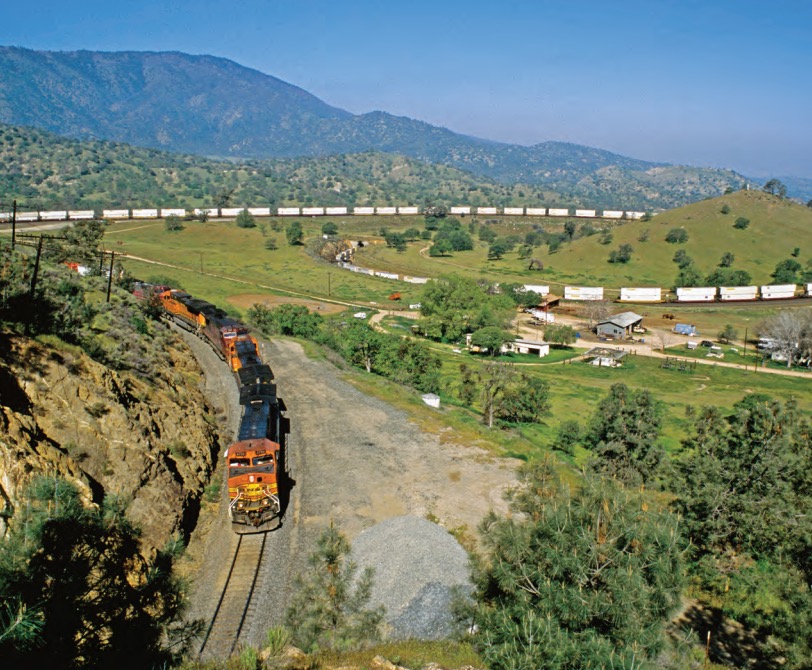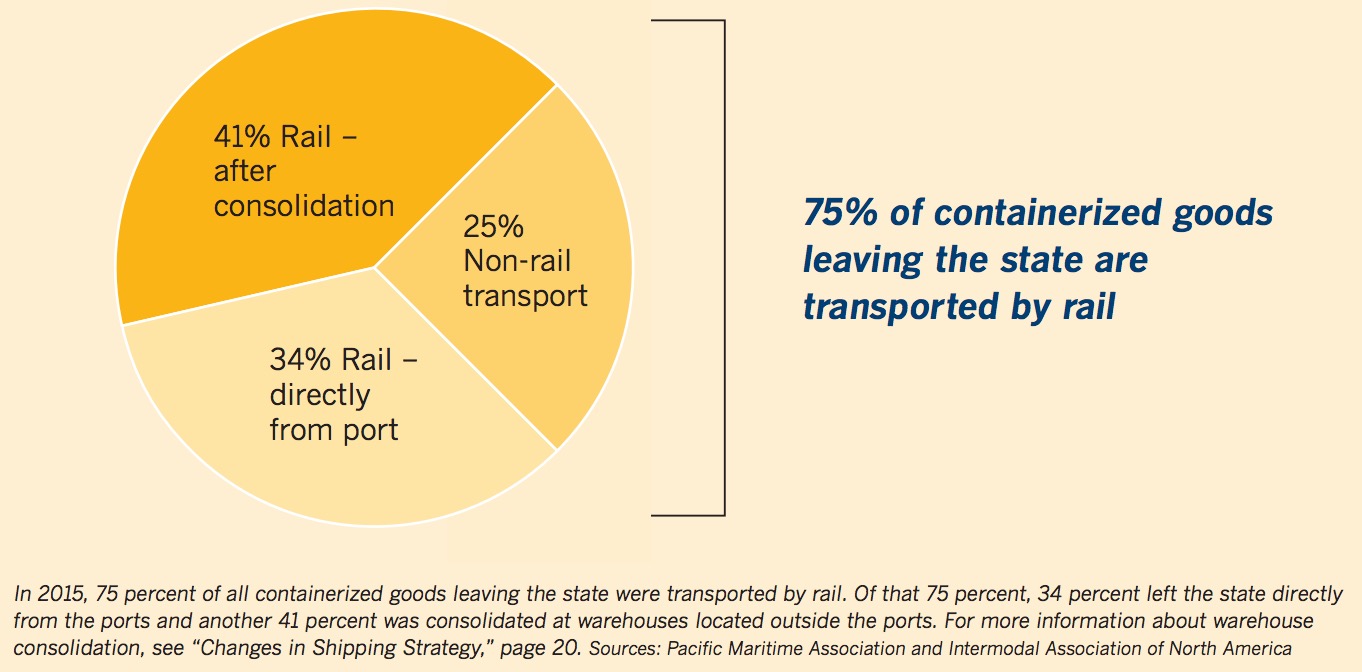UNIVERSITY OF CALIFORNIA, BERKELEY
INSTITUTE OF TRANSPORTATION STUDIES
Railroads and the Golden State
Introduction
 The state of California has long been the economic leader of the United States. Its output is commonly compared not to its fellow states, but to countries, most recently ranking as the sixth largest economy in the world. The nation’s most populous state is home to five major metropolitan areas — Sacramento, San Francisco, San Jose, Los Angeles, and San Diego — and globally influential industries, including agriculture, high tech, defense, and entertainment.
The state of California has long been the economic leader of the United States. Its output is commonly compared not to its fellow states, but to countries, most recently ranking as the sixth largest economy in the world. The nation’s most populous state is home to five major metropolitan areas — Sacramento, San Francisco, San Jose, Los Angeles, and San Diego — and globally influential industries, including agriculture, high tech, defense, and entertainment.
A broad investment in all types of transport has been critical to California’s economic success, and rail is a fundamental component of the transportation system. Rail has helped define California’s history, with westward expansion creating communities and allowing for growth in agriculture, and other early drivers of the state’s economy. With the coming high-speed rail system and record traffic in containerized freight, it is also helping to define the state’s future.
Within this broader context, Rail and the California Economy summarizes a California State Transportation Agency research project, led by the Institute of Transportation Studies at the University of California, Berkeley, investigating how the state’s vast passenger and freight rail system contributes to the Golden State’s economy today and what factors could impact these contributions going forward. Conclusions and assertions within this publication reference material sourced within this project, including existing and original research, publically available data, and stakeholder discussions throughout the state. Sources outside the project’s research reports are footnoted.
California’s transportation system is approaching capacity in many different locations. Multiple sources regularly rank segments of the state’s freeways as among the worst for congestion and delays. Light rain or fog can cause numerous delays at our major airports. There are rail corridors where additional passenger service is not offered due to capacity constraints. California’s population will grow from 39 million in 2015 to a projected 50 million residents by 2050, according to the Department of Finance estimates. So efficient movement of freight and people — while assuring safety, meeting air-quality goals and environmental standards, and avoiding unreasonable travel delays — is an ongoing challenge.
This report also supports two other transportation documents, the 2018 State Rail Plan and the California Transportation Plan 2040.
- California accounted for over $400 billion of U.S. imports in 2015, about 18 percent of the national total.
- In 2012, 27 percent of U.S. rail intermodal shipments originated in California, and 23 percent terminated there.
- Among state-supported Amtrak services, 10 of the 20 busiest rail stations in the United States in 2015 are in California.

State of the System
California has one of the most diverse networks of rail in the United States, ranging from lightly-used branch lines in the northern interior to a heavily-trafficked triple-track mainline near downtown Los Angeles. Rail service stretches from the country’s largest container port, located in Southern California’s San Pedro Bay, and from below–sea level in the agricultural region of the Imperial Valley to the transcontinental crossing of Donner Pass at over 7,000 feet. Within this network are intercity passenger routes, regional rail corridors, long-haul interstate freight lines, and freight short lines. Together, this network moves thousands of passengers and millions of tons of cargo per day.
California has almost 4,000 miles of track owned by the two Class I railroads, Union Pacific and BNSF, according to the 2013 California State Rail Plan. An additional 800 route miles are operated by short-line railroads — smaller operators covering short, often regionally based distances — or public agencies.
Three intercity passenger routes connect the major cities in the state. The Capitol Corridor runs from Auburn to San Jose, the Pacific Surfliner runs from San Luis Obispo to San Diego via Los Angeles, and the San Joaquins runs from Oakland and Sacramento to Bakersfield. Four long-distance Amtrak services — Sunset Limited, Coast Starlight, California Zephyr, and Southwest Chief — supplement these corridors, arriving from outside the state. An extensive Amtrak Thruway motorcoach network connects 13 additional communities in every corner of the state to existing California Amtrak stations.
Intercity routes are supplemented by four major regional rail systems: Caltrain from Gilroy to San Francisco via San Jose, Altamont Corridor Express (ACE) from Stockton to San Jose, Coaster from Oceanside to San Diego, and the multi-line Metrolink network serving Los Angeles, Orange, Riverside, San Bernardino, and Ventura counties, as well as Oceanside in San Diego County.
While central to the economy of the regions, heavy rail or “metro” networks, such as BART or LA Metro, are outside the scope of this report, as are local light-rail services that serve Los Angeles, Sacramento, San Diego, San Francisco, and San Jose. Likewise, high-speed rail is not yet part of the existing system and thus not part of this evaluation.
How Railroads Serve the California Economy
Freight and passenger rail serve California in a variety of ways. Most directly, passengers and shippers who use rail can save money and time — savings that can often be directly measured by comparing the rail service with users’ options on alternative modes. In many cases, however, trips or shipments made on rail would simply not be made if the service were not available, according to survey data. For freight, this is particularly the case for specific hazardous materials.
In addition, by redirecting traffic off of the roadways, rail use spares everyone from higher automobile and truck volumes, curtailing traffic congestion, air pollution, carbon emissions, road wear (and the costs associated with it), and crashes, and allows investments in roadway expansion, where it is even possible, to be deferred. The numbers are extraordinary: A typical container train can haul the same load as 100 trailer trucks, while a rail trainset — a group of passenger cars coupled together — can serve more than 1,000 passengers at a time and is constrained mainly by platform length, which, in many cases, can be lengthened.
More fundamentally, the availability of rail service shapes California’s economic landscape. From the South, where ports and warehouses handle massive import flows to be transported by rail around the country, to the North, where Caltrain offers commuters a reliable alternative to clogged Silicon Valley freeways, rail services enable industrial activities that generate employment, wealth, and innovation.
Download full version (PDF): Rail and the California Economy
About the University of California, Berkeley Institute of Transportation Studies
its.berkeley.edu
For more than 60 years, the Institute of Transportation Studies at the University of California, Berkeley, has been recognized as one of the world’s leading centers for transportation research, education, and scholarship.
Tags: CA, California, Freight, Institute of Transportation Studies, Railroads, UC Berkeley, University of California






 RSS Feed
RSS Feed